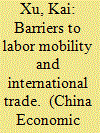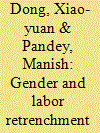|
|
|
Sort Order |
|
|
|
Items / Page
|
|
|
|
|
|
|
| Srl | Item |
| 1 |
ID:
133191


|
|
|
|
|
| Publication |
2014.
|
| Summary/Abstract |
This paper quantitatively evaluates the potential impacts of removing China's Hukou system on the world economy. By denying migrant workers the right to health benefits and housing, China's Household Registration (Hukou) system presents a significant distortion to the Chinese labor market that discourages the reallocation of its labor from agriculture to non-agriculture. I find that the elimination of Hukou could increase China's real income per capita by about 4.7%. Moreover, although for most countries the impact of removing Hukou is modest (less than 1% changes in real income per capita), substantial changes in real income could take place for China's small neighboring economies. For example, the decreases in real GDP per capita are 2.7%, 3.2%, and 4.1% for Bangladesh, Sri Lanka, and Vietnam, while Thailand stands to enjoy a 3.8% increase in its income.
|
|
|
|
|
|
|
|
|
|
|
|
|
|
|
|
| 2 |
ID:
112727


|
|
|
|
|
| Publication |
2012.
|
| Summary/Abstract |
In the late 1990s, China's state-owned enterprises (SOEs) underwent dramatic labor retrenchment, drawing considerable attention to how women fared relative to men during the retrenchment process. However, almost all the existing studies on the subject rely on individual-level data. In this paper, we study the gender patterns of SOE labor retrenchment using a unique enterprise-level dataset for the period from 1995 to 2001. We find that disproportionately large share of discharge was borne by female workers and that female discharge rates were more sensitive to output growth than male discharge rates. Further, estimating dynamic labor demand equations by gender, we find that female employment was more sensitive to negative output shocks experienced by enterprises than male employment but less sensitive to positive output shocks. Further, we find that sensitivity of female employment to output was greater for reformed than non-reformed enterprises and for male-intensive than female-intensive sectors. These results provide new insights into the gender patterns of employment adjustment of Chinese SOEs to output shocks during the retrenchment period.
|
|
|
|
|
|
|
|
|
|
|
|
|
|
|
|
| 3 |
ID:
078036


|
|
|
|
|
| Publication |
2007.
|
| Summary/Abstract |
Empirical models are developed in this paper to quantitatively analyze households' participation in decisions on hiring labor and supplying labor off the farm, hired labor demand and off-farm labor supply of rural Chinese households. Econometric estimates use micro-level data from Zhejiang province over the period 1995-2002. The main results suggest that the decisions to hire labor and participate off the farm are made jointly and are positively correlated. A household's labor demand decreases with increasing wages for hired labor, whereas the effect of the wages of off-farm workers on a household's labor supply differs significantly depending on the household's kind of labor market participation. The results also indicate that the accumulation of productive assets, the development of livestock production and agricultural prices have increasing effects on labor demand but reducing effects on a household's off-farm labor supply. Land market integration enhances participation significantly but has no significant impact on time allocation. Finally, the results suggest non-separability between hired labor demand and household characteristics, indicating the rural labor market in Zhejiang province is still functioning imperfectly
|
|
|
|
|
|
|
|
|
|
|
|
|
|
|
|
| 4 |
ID:
136237


|
|
|
|
|
| Summary/Abstract |
Germany continues to play a pioneering role in replacing conventional power plants with renewable energy sources. While this might be beneficial with respect to environmental quality, it also implies increasing electricity prices. The extent to which this is associated with negative impacts on employment depends on the interrelationship between labor and electricity as input factors in the production process. In this paper, we estimate cross-price elasticities between electricity and heterogeneous labor for the German manufacturing sector. We use administrative linked employer–employee micro-data combined with information on sector-level electricity prices and usage over the period 2003–2007. We find positive, but small conditional cross-price elasticities of labor demand with respect to electricity prices, which means that electricity as an input factor can be replaced by labor to a limited extent when the production level is held constant. In the case of adjustable output, we find negative unconditional cross-price elasticities, implying that higher electricity prices lead to output reductions and to lower labor demand, with low- and high-skilled workers being affected more than medium-skilled. Resulting adverse distributional effects and potential overall job losses may pose challenges for policy-makers in securing public support for the German energy turnaround.
|
|
|
|
|
|
|
|
|
|
|
|
|
|
|
|
|
|
|
|
|